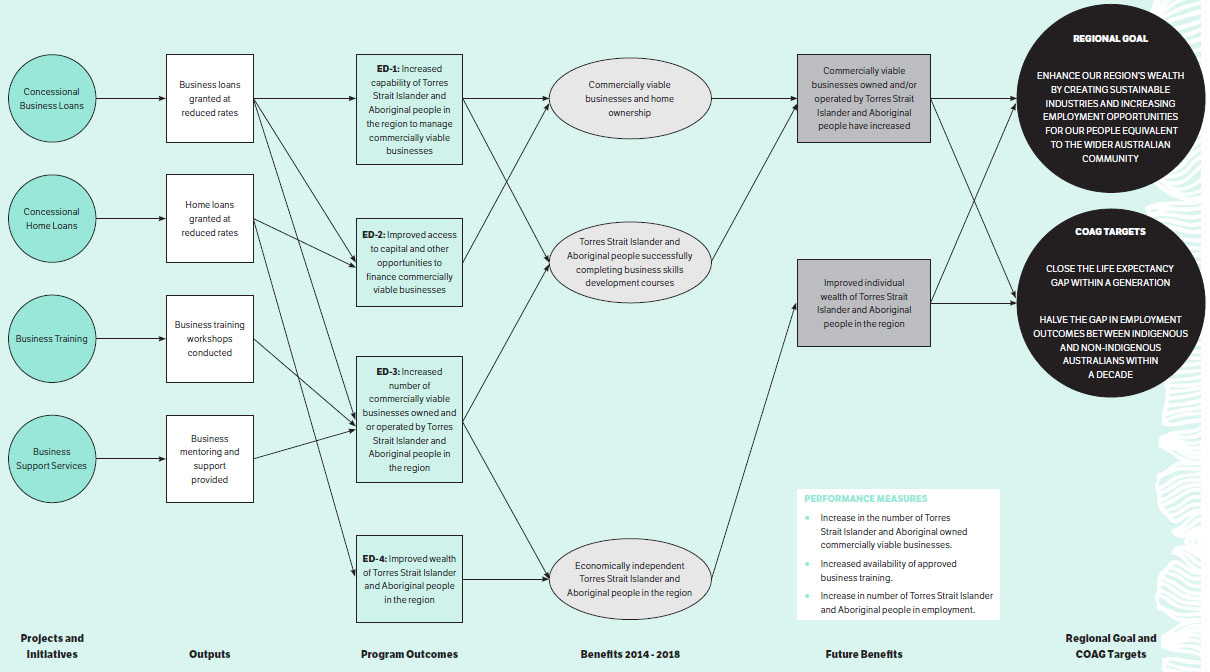Overview and Aims
Economic stability and growth are essential for the development of the Torres Strait and Northern Peninsula region. Welfare dependency is too high and we need to assist people to achieve economic independence. The support and skills training needed to assist Indigenous people to transition to full-time work, take on higher level jobs, or own and operate their own businesses are inadequate. It is vital that jobs that generate real wealth for the individual, the community and the region are created. It is important to foster sustainable industries owned and operated by Indigenous people so that the region has a strong future. The Economic Development Program will contribute to regional, community and individual economic improvement by taking the lead as the whole of region economic development solution broker.
The program aims are to:
- stimulate economic development across the region
- advance business skills and align training initiatives with regional employment opportunities
- advance Torres Strait Islander and Aboriginal ownership and management of businesses in the region
Regional Goal
Enhance our region’s wealth by creating sustainable industries and increasing employment opportunities for our people equivalent to the wider Australian community.
Regional Issues
- Lack of appropriate training and support to assist Torres Strait Islander and Aboriginal people to own and operate sustainable enterprises.
- Lack of training to skill up local Torres Strait Islander and Aboriginal people so that they can work within various enterprises.
- High costs of basic services impacting on the viability of regional industries and community enterprises.
- Lack of some critical infrastructure, such as broadband connectivity and access to banking infrastructure.
- High unemployment across the Torres Strait (unemployment is 11.4 per cent, 5.4 per cent higher than the Queensland average). Based on data provided by the Queensland Government Statistician, in June 2013, 175 people in the Northern Peninsula Area, 191 people in the Torres Shire Council area and 264 people in the Torres Strait Island Regional Council area were unemployed.
- Few commercially viable business opportunities can be established in remote communities.
Program Outcomes
- [ED-1] Increased capability of Torres Strait Islander and Aboriginal People in the region to manage commercially viable businesses.
- [ED-2] Improved access to capital and other opportunities to finance commercially viable businesses.
- [ED-3] Increased number of commercially viable businesses owned and or operated by Torres Strait Islander and Aboriginal people in the region.
- [ED-4] Improved wealth of Torres Strait Islander and Aboriginal people in the region.
Benefits
2014 – 2018
- Torres Strait Islander and Aboriginal people successfully completing business skills development courses.
- Economically independent Torres Strait Islander and Aboriginal people in the region.
- Commercially viable businesses and home ownership.
Future Development Plans
- Commercially viable businesses owned and/or operated by Torres Strait Islander and Aboriginal people have increased.
- Improved individual wealth of Torres Strait Islander and Aboriginal people in the region.
Performance Measures
- Increase in the number of Torres Strait Islander and Aboriginal owned commercially viable businesses.
- Increased availability of approved business training.
- Increase in number of Torres Strait Islander and Aboriginal people in employment.
Projects and Initiatives
The Economic Development Program has a mandate from the TSRA Board to undertake the following projects and initiatives:
- concessional home loans
- concessional business loans
- business training
- business support services.
Contribution to the Closing the Gap Targets
The Economic Development Program will contribute to the following Closing the Gap targets:
- Target #1: close the gap in life expectancy within a generation.
- Target #6: halve the gap in employment outcomes between Indigenous and non-Indigenous Australians within a decade.
Contribution to COAG National Partnership Agreement Indigenous-specific Outcomes
The Economic Development Program will contribute to the following National Partnership Agreement Indigenous-specific outcomes:
- The Indigenous working age population has the depth and breadth of skills and capabilities required for the 21st century labour market.
- Indigenous people of working age participate effectively in all sectors and at all levels of the labour market.
Annex A-1 Program Map – Economic Development
Annex A-2 Economic Development Program – Overview
Annex A-2 Economic Development Program – Overview
| Overview and aims | Benefits | Outcomes | Performance measures | Initiatives |
|---|---|---|---|---|
|
The Economic Development Program will undertake projects and activities which will lead to the fulfilment of the regional goal: Enhance our Region’s wealth, by creating sustainable industries and increasing employment opportunities for our people equivalent to the wider Australian community. The program aims are to:
|
|
2014 – 2018
Future Development Plans
|
|
The Economic Development Program has a mandate to undertake the following initiatives:
|
Annex A-3 Economic Development Program – Benefits
Annex A-3 Economic Development Program – Benefits
| Benefits | Performance measures | Targets | Target groups |
|---|---|---|---|
| Commercially viable businesses and home ownership. | Increase in the number of Torres Strait Islander and Aboriginal owned commercially viable businesses. | Five new business loans per year from 2014 to 2018. Three new home loans per year from 2014 to 2018. |
Torres Strait Islander and Aboriginal people. |
| Torres Strait Islander and Aboriginal people successfully completing business skills development courses. | Increased availability of approved business training. | Eight business workshops conducted each year from 2014 to 2018. | Torres Strait Islander and Aboriginal people interested in operating a business. |
| Economically independent Torres Strait Islander and Aboriginal people in the region. | Increase in number of Torres Strait Islander and Aboriginal people in employment. | Five percent of Remote Jobs and Communities Program (RJCP) Region 59 participants move into employment each year. | Torres Strait Islander and Aboriginal people. |


